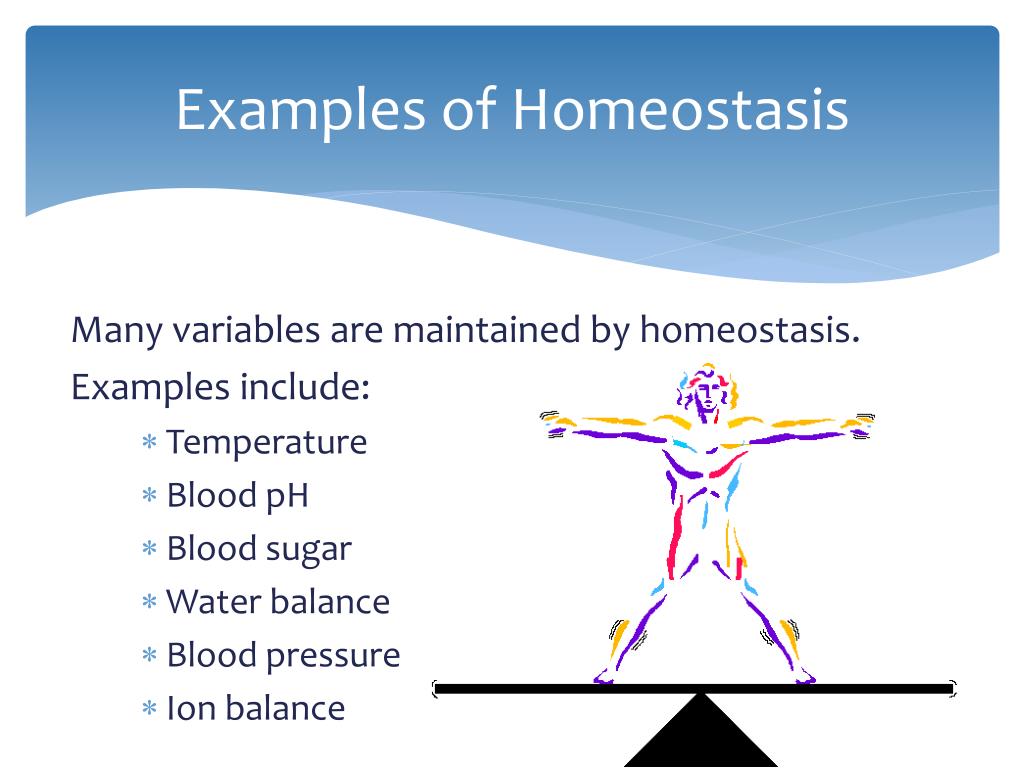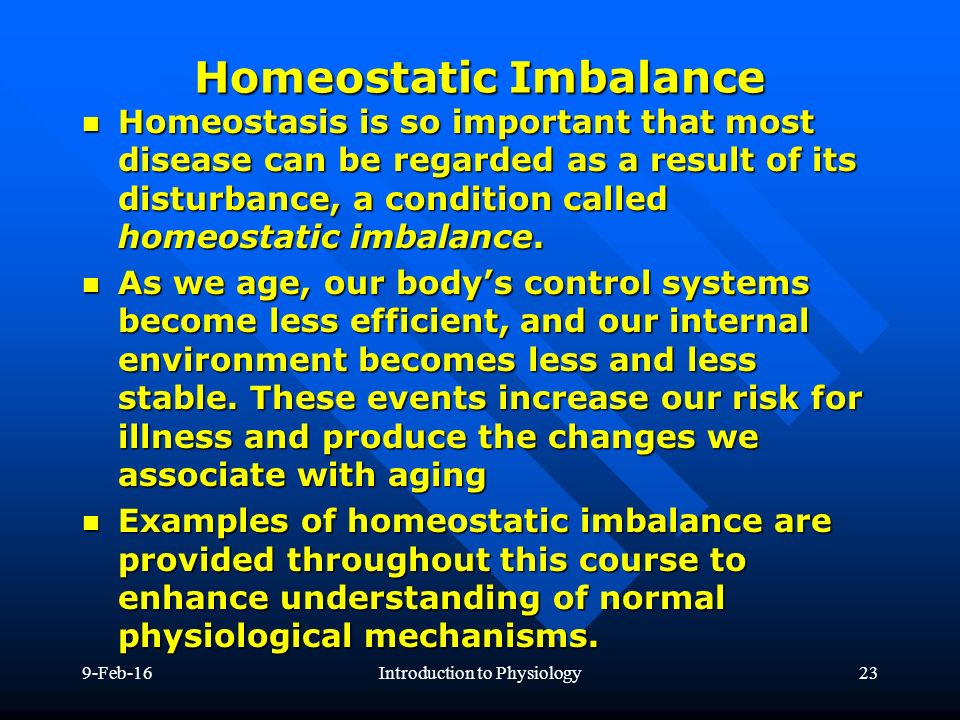A Result Of Homeostatic Imbalance Could Be

The human body, a marvel of biological engineering, constantly strives for homeostasis, a state of equilibrium essential for survival. When this delicate balance is disrupted, the consequences can range from minor discomfort to life-threatening conditions. Understanding the potential outcomes of homeostatic imbalance is crucial for promoting preventative healthcare and developing effective treatments for a wide array of diseases.
This article delves into the ramifications of disrupted homeostasis, exploring specific conditions that arise when the body's internal environment deviates from its optimal range. We will examine the mechanisms underlying these imbalances, focusing on how they manifest as diseases and what can be done to restore equilibrium. Our analysis will draw upon the latest research and insights from leading medical experts and organizations.
Diabetes Mellitus: A Case of Glucose Dysregulation
Perhaps one of the most well-known examples of homeostatic imbalance is diabetes mellitus. This chronic metabolic disorder is characterized by elevated blood glucose levels, resulting from defects in insulin secretion, insulin action, or both. The consequences of prolonged hyperglycemia are widespread and devastating.
According to the World Health Organization (WHO), the number of people with diabetes has risen dramatically over the past few decades, posing a significant global health challenge. The body's inability to regulate glucose effectively leads to a cascade of complications.
These include damage to the heart, blood vessels, eyes, kidneys, and nerves. This damage is caused by the prolonged exposure of tissues to high glucose concentrations, leading to glycation of proteins and other cellular components.
Type 1 Diabetes: An Autoimmune Assault
Type 1 diabetes is an autoimmune disease in which the body's immune system mistakenly attacks and destroys the insulin-producing beta cells in the pancreas. As a result, individuals with type 1 diabetes require lifelong insulin therapy to survive.
The loss of insulin production disrupts glucose homeostasis, forcing individuals to carefully manage their diet, exercise, and insulin injections. Without meticulous management, individuals can experience dangerous fluctuations in blood glucose levels.
These fluctuations can lead to both acute complications like diabetic ketoacidosis (DKA) and long-term complications such as cardiovascular disease and neuropathy.
Type 2 Diabetes: Insulin Resistance and Pancreatic Fatigue
Type 2 diabetes, the more prevalent form of the disease, is characterized by insulin resistance, where the body's cells become less responsive to insulin. Over time, the pancreas may also lose its ability to produce enough insulin to overcome this resistance, exacerbating the hyperglycemic state.
Lifestyle factors, such as obesity, physical inactivity, and poor diet, play a significant role in the development of type 2 diabetes. These factors contribute to insulin resistance and pancreatic dysfunction, disrupting glucose homeostasis.
Management of type 2 diabetes often involves lifestyle modifications, such as diet and exercise, as well as medications to improve insulin sensitivity or stimulate insulin secretion.
Hypertension: The Silent Killer
Another critical aspect of homeostasis is blood pressure regulation. Hypertension, or high blood pressure, is a condition in which blood pressure remains consistently elevated, placing undue stress on the cardiovascular system.
According to the Centers for Disease Control and Prevention (CDC), hypertension is a major risk factor for heart disease, stroke, kidney disease, and other serious health problems. It is often referred to as the "silent killer" because it typically has no symptoms until complications arise.
The body maintains blood pressure through a complex interplay of hormones, nerves, and blood vessels. When these regulatory mechanisms are disrupted, blood pressure can rise to dangerous levels.
The Role of the Renin-Angiotensin-Aldosterone System (RAAS)
The RAAS is a hormonal system that plays a crucial role in regulating blood pressure and fluid balance. Dysregulation of the RAAS can contribute to hypertension.
For example, excessive activation of the RAAS can lead to increased sodium and water retention, as well as vasoconstriction, both of which increase blood pressure. Certain medications used to treat hypertension target the RAAS to restore blood pressure control.
These medications include ACE inhibitors, ARBs, and aldosterone antagonists, which work by blocking different steps in the RAAS pathway.
Lifestyle Factors in Hypertension
Lifestyle factors, such as high sodium intake, lack of physical activity, obesity, and excessive alcohol consumption, can also contribute to hypertension. Addressing these factors through lifestyle modifications is often a key component of hypertension management.
A healthy diet, regular exercise, weight management, and limiting alcohol intake can all help lower blood pressure and reduce the risk of cardiovascular complications. In some cases, lifestyle changes alone may be sufficient to control hypertension, while in others, medication may also be necessary.
Dehydration: A Threat to Fluid Balance
Maintaining adequate hydration is essential for proper bodily function. Dehydration occurs when the body loses more fluid than it takes in, leading to a disruption of fluid and electrolyte balance.
Severe dehydration can be life-threatening, especially for infants, young children, and older adults. The body tightly regulates fluid balance through hormones, kidneys, and thirst mechanisms.
Conditions that disrupt these regulatory mechanisms, such as vomiting, diarrhea, excessive sweating, and certain medications, can lead to dehydration.
Consequences of Dehydration
Dehydration can lead to a variety of symptoms, including thirst, fatigue, dizziness, headache, and decreased urine output. In severe cases, dehydration can cause confusion, seizures, and even death.
The kidneys play a crucial role in maintaining fluid balance by regulating the excretion of water and electrolytes. When the body is dehydrated, the kidneys conserve water by producing more concentrated urine.
Prompt rehydration with fluids and electrolytes is essential to restore fluid balance and prevent complications. In severe cases, intravenous fluids may be necessary.
Looking Ahead: Restoring Homeostasis
Understanding the mechanisms underlying homeostatic imbalances is crucial for developing effective prevention and treatment strategies. Advances in medical research are continuously providing new insights into these complex processes, leading to more targeted and personalized therapies.
Focusing on lifestyle factors, early detection, and appropriate medical interventions can help prevent and manage conditions resulting from homeostatic imbalance. Further research is needed to fully elucidate the intricate interactions within the body's regulatory systems.
This will hopefully lead to innovative approaches for restoring and maintaining homeostasis, improving overall health and well-being for individuals across the globe. Maintaining homeostasis is not just about treating diseases, it's about proactively fostering a state of equilibrium that allows the body to thrive.


















